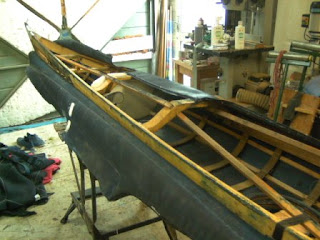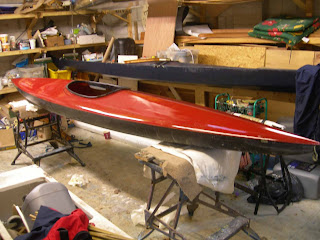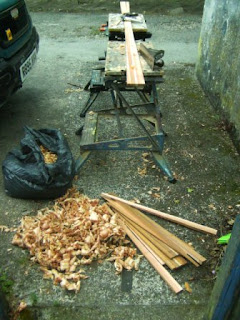Rebuilding the Alacrity
The Alacrity
The boat in question was built in a hurry in 2010 in preparation for a class in which a couple of boats to this design were built. It was my version of the Brian Schultz Ginnyak, some six inches longer with a finer bow so as to be able to negotiate a chop better - which was a problem he had identified with his design.
I had re-covered it in late 2012 for the 2013 Anglesey sea kayak symposium but with two hatches and two foam bulkheads; the boat was never so good after I did this and I abandoned bulkheads altogether a couple of years later. For a number of reasons, I came to consider that they were not really compatible with skin on frame kayaks (good subject for another post).
Why rebuild the Alacrity?
A few reasons; it hadn't paddled straight for over a year or so, it was a bit too tippy for me to use much in any kind of a sea - I like to be able to relax a bit these days. I was never happy with the enamel paint coating of the polyester fabric being prone to leakage - there was always some water coming in. Because I was unable to sand down paint on top of fabric, it was not possible to over paint the original coating of 2012 (the broken fibres form a rough surface with the next coat of paint).
Most of all I wanted to try out some design improvements I had incorporated into the Lowen plans that I was producing, particularly the arrangement of the bow assembly. Through re-building with frames rather than steam bent ribs, I also thought that I could improve the design with some developments I had incorporated into the Lowen.
Stripping
One of the best things that can be said for an enamel paint coating was the ease with which the skin could be cut off a boat:
The skin weighed 3kg
and flat on the floor looked like this:
The bow of the frame had gone quite mouldy
Although there was a small soft area, most of the wood was good enough. There was probably no air circulation in such a restricted area, and as skin on frame boats are generally stored upside down, moisture would have collected there. Fortunately I generally use Cedar which is one of the better species for rot resistance, for the bow and stern plates. However there were some lessons on design practicalities here to be learned. The stern section was also damp but perhaps as it was not such an extreme shape as the bow there was no mould or soft wood:
On looking closely at forward quarter of the frame I noticed that three ribs had been pushed across to the starboard side of the boat to the extent that one had broken.
This may have been the cause of the directional instability and also the slight hogging of the keel at this point. Otherwise the frame was not looking too bad:
You can see the bulkheads still in place. Now to work out what to do next!
The boat in question was built in a hurry in 2010 in preparation for a class in which a couple of boats to this design were built. It was my version of the Brian Schultz Ginnyak, some six inches longer with a finer bow so as to be able to negotiate a chop better - which was a problem he had identified with his design.
I had re-covered it in late 2012 for the 2013 Anglesey sea kayak symposium but with two hatches and two foam bulkheads; the boat was never so good after I did this and I abandoned bulkheads altogether a couple of years later. For a number of reasons, I came to consider that they were not really compatible with skin on frame kayaks (good subject for another post).
Why rebuild the Alacrity?
A few reasons; it hadn't paddled straight for over a year or so, it was a bit too tippy for me to use much in any kind of a sea - I like to be able to relax a bit these days. I was never happy with the enamel paint coating of the polyester fabric being prone to leakage - there was always some water coming in. Because I was unable to sand down paint on top of fabric, it was not possible to over paint the original coating of 2012 (the broken fibres form a rough surface with the next coat of paint).
Most of all I wanted to try out some design improvements I had incorporated into the Lowen plans that I was producing, particularly the arrangement of the bow assembly. Through re-building with frames rather than steam bent ribs, I also thought that I could improve the design with some developments I had incorporated into the Lowen.
Stripping
One of the best things that can be said for an enamel paint coating was the ease with which the skin could be cut off a boat:
The skin weighed 3kg
and flat on the floor looked like this:
The bow of the frame had gone quite mouldy
Although there was a small soft area, most of the wood was good enough. There was probably no air circulation in such a restricted area, and as skin on frame boats are generally stored upside down, moisture would have collected there. Fortunately I generally use Cedar which is one of the better species for rot resistance, for the bow and stern plates. However there were some lessons on design practicalities here to be learned. The stern section was also damp but perhaps as it was not such an extreme shape as the bow there was no mould or soft wood:
On looking closely at forward quarter of the frame I noticed that three ribs had been pushed across to the starboard side of the boat to the extent that one had broken.
This may have been the cause of the directional instability and also the slight hogging of the keel at this point. Otherwise the frame was not looking too bad:
You can see the bulkheads still in place. Now to work out what to do next!










Comments
Post a Comment